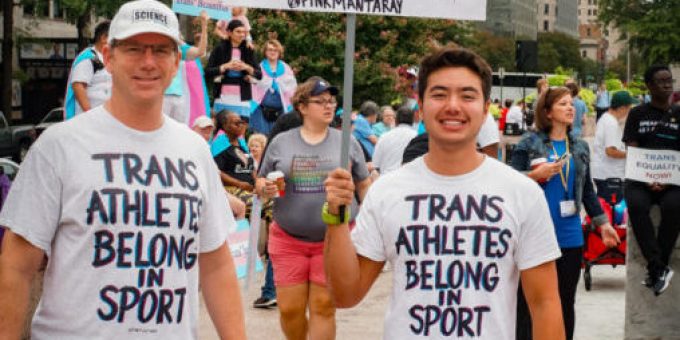
As a sport sociologist, much of my research focuses on how sports offer sites and content that people use to express and work out their cultural and political values and beliefs. Prominent among these beliefs are their understandings of sex, gender, and sexuality. Oftentimes, people are not aware of how their beliefs and emotions are manipulated in sport settings. Other times, they seek to use sports to further their own ends. Therefore, it is important to continually and critically evaluate what seems to be transpiring.
Sports and Sex, Gender, and Sexuality
Sports are a major sphere of life where we learn about sex, gender, and sexuality. As sociology of sport scholars have often observed, these dynamics are shaped by, and also affect broader social structures, cultures, understandings, and interactions. In fact, sport platforms and content have been famously and publicly used to draw attention to social issues involving sex, gender, and sexuality– and even instigate social changes, too. Many award-winning books have been written about the complexity and far-reaching consequences of these processes.

Concerns about sex, gender, and sexuality have long been present in sports and society. Indeed, there have been legacies of mistreatment because of sex, gender, and sexuality differences in both sports and society. There has also been continued resistance to respecting changing understandings of sex, gender, and sexuality and efforts to expand civil rights and practices of inclusivity. Protections under the law can apply to sport and societal interactions and modify these practices.
As sex, gender, and sexuality were being contested in recent years, transgender rights became strategically targeted as a prominent new front for the culture wars by right-leaning activists. It soon became apparent that the activists were becoming successful in creating a moral panic surrounding trans athletes, in particular. This has led to rights for transgender athletes becoming a focal point for discussions of what constitutes sex discrimination and what rights transgender individuals should have in sports and society.
Apparently due to targeted political messaging and policy initiatives, and some disgust at high profile athletic victories by transwomen, public opinion polling has evidenced quite dramatic upticks in opposition to transgender athletes’ rights to choose who they compete with. Anti-trans campaigns have also encouraged dehumanizing comments toward transgender people and vicious attacks surrounding them.
These dynamics may work to roll back LGBTQIA+ rights in sports and society as people feel emboldened to express outrage and engage in backlash to expansions of LGBTQIA+ rights and an increased visibility of LGBTQIA+ individuals in sports and society. New pending guidance for Title IX’s application to school sports will offer additional challenges to people’s comfort levels with the old ways of doing things.
What is Sex Discrimination? What rights do LGBTQIA+ individuals have?
Contestations over LGBTQIA+ rights in society have been especially heated in recent decades. Under President Obama the Department of Education offered guidance on Title IX enforcement that included explicit acknowledgement of rights based on sexual orientation and gender identity. This guidance expanded protection from sex discrimination, which was established with Title IX of the 1972 Educational Amendments to the Civil Rights Act of 1964, to gender identity and sexual orientation. The Obama administration argued that protections from sex-based discrimination extend to gender identity and sexual orientation because gender-identity and sexual-orientation based mistreatment would not occur, hypothetically, if the victim of mistreatment had a different biological sex. Under President Trump that guidance was reversed and attempts were made to further narrow understandings and applications of sex discrimination. For instance, the Trump administration emphasized the relevance of sex categorizations at birth while dismissing the relevance and legal ramifications of gender identities, especially when they differed from natal sex categorizations. In 2020, a landmark Supreme court case about employment discrimination bolstered Obama-era claims and led President Biden to reaffirm and explicitly identify protections based on sexual orientation and gender identity for employment and for a discrimination-free environment for education.
There is now particularly focused attention and concern about the application of Title IX for school sports. School sports offer unique settings for evaluating sex discrimination compared to the workplace, for example, because male and female bodies are different, on average, in ways that may affect athletic performance and almost all school sport competition occurs in sex segregated settings. In fact, Title IX is famously known for regulating evaluations of sex discrimination in school sports. The traditional guidance has focused upon equalizing the proportion of male and female athletes, accommodating female students who wish to play sports, and ensuring that the interests of the underrepresented sex are met. This guidance, and how Title IX has been applied more generally, has resulted in remarkable effects on sports and society—although all of them have not been as uniformly positive as most people assume. Still, Title IX is associated with massive increases in sports-related opportunities for girls and women that have had major impacts on their lives, and the lives of others, within and outside of sports. Nevertheless, Title IX’s legacy is integrally wrapped up with continual contestations over what sex discrimination entails and backlashes from those resistant to the expansion of sex-related rights in sports and society.Title IX and Sports
Consequently, broader considerations of gender identities, disputes over the definitions of sex and gender, and concerns about how sex differences manifest themselves in athletic performances have led to extreme caution in the final release of Title IX guidelines for school sports. Final specific guidance for its application is now forthcoming in October.
Nevertheless, it has already been signaled that the expected guidance will rely upon the same set of protections from sex, sexual orientation, and gender identity-based discrimination. But, because of sexed differences in bodies and widespread sex/gender segregation of school sports, schools will need to prove needs for disallowing transgender, nonbinary, and/or intersex students from school sports that align with their gender identities or otherwise offer challenges to assumptions of clearcut, stable, and concordant sex/gender binaries. Schools will be expected to prove that there are competitive and/or injury concerns that are related to educational purposes to justify such decisions and they cannot result in blanketed bans for all sports at all levels. Bans for lower levels of sport and for activities in which average sex differences would seem to matter little are unlikely to be supported, the Title IX guidance states.
The Broader Significance of LGBTQIA+ Rights in Sports
A preoccupation with how transgender individuals fit in with the structure of school sports has narrowed the framing of broader pushes for LGBTQIA+ civil rights to a single controversial issue. This focus has stigmatized and demonized transgender individuals, led to renewed debates about what sex and gender entail, and prompted backlash. Recently, this backlash even extended to mainstream corporations that, while traditionally beloved by conservatives, released marketing inclusive of transgender individuals and the LGBTQIA+ community.
Accompanying this, as Gallup has noted, there has been a marked increase in U.S. adults’ opposition to transgender inclusion on the basis of gender identities in school sports. Gallup analyzed the changing views of transgender inclusion between 2021 and 2023 using two national surveys that asked the same question both times. The survey question asks if people think that transgender athletes should be able to play on sports teams that match their current gender identity or if they believe transgender athletes should only be allowed to play on sports teams that match their birth gender. The results demonstrate a 7% increase between 2021 and 2023, from 62% to 69%, in opposition to allowing transgender athletes to play on sports teams that align with their gender identity. Although the increase was rather broad-based, across respondents’ political affiliations, genders, most age categories, race/ethnicity, and education, the data show no change in opposition amongst Conservatives (85% of whom were already opposed in 2021), some change among Liberals (i.e., from 32% to 37%), and a dramatic 16% change among Moderates (from 62% to 78% opposed).
My own collaborative research results from the 2018-19 National Sports and Society Survey (NSASS), that asked 4,000 U.S. adults about the extent to which they (dis)agreed with allowing transgender athletes to compete with their choice of male or female athletes found majority support for transgender athletes’ rights to choose. Taken together, these findings show increasing opposition to trans rights over time. We attribute our survey findings of majority support for trans rights to much more modest opposition to such rights in athletics largely before political mobilization against trans athletes emerged and before the passage of the first state-level ban on transgender athletes in 2020. In addition, this finding may reflect our question’s focus on rights and not on natal sex categorizations of sex-segrated teams, consideration of non-elite competitive sports, and lack of specifying different rights for transmen and transwomen. Also, our respondents were disproportionately more liberal and LGBTQIA+ identified. Despite these limitations, we found disparities in opposition based on conservatism and political party identifications that are comparable to the Gallup findings. Only self-identified conservatives and republicans were more opposed than supportive of trans rights—no other demographic, identity, or social group affiliation demonstrated this pattern. But, we discovered much more modest male-female and liberal-moderate differences compared to Gallup, suggesting that male and politically moderate respondents became much more markedly opposed to trans athlete rights in recent years.In addition, our study allows for comprehensive comparisons along more expansive gender and sexual identity categorizations and ideological stances. We used advanced statistical techniques to isolate the independent and combined relevance of demographic characteristics, social groups, self-identities, and related ideologies on participants’ support for transgender athletes’ rights. We found that nonbinary and sexual minority respondents were overwhelmingly supportive of trans athletes’ rights, as one might expect. Less than 10% of nonbinary adults and less than 25% of adults who did not identify as heterosexual expressed opposition to trans athletes’ rights. Moreover, we found about a 30% difference in the likelihood of supporting transgender athletes’ rights between adults who supported gender-based separate spheres (i.e., breadwinning vs. homemaking) and believed female athletes’ were inferior relative to male athletes compared to those who did not support these beliefs.
Together, demographic characteristics, identities, and beliefs led to stark differences in support for transgender athletes’ rights. For example, respondents who were male, heterosexual, 51+ years old, Republican, Christian, Conservative, and strongly agreed with separate spheres and female athletes’ inferiority had only a .06 predicted probability of supporting transgender athletes’ rights. Respondents who were female, gay/lesbian, young adult, Democratic, secular, Liberal, and strongly disagreed with separate spheres and female athletes’ inferiority adults, however, were 15 times more likely to support trans athletes’ rights, with a predicted probability of .90. Nonbinary adults with similar characteristics were even more likely to support transgender athletes’ rights.

These findings highlight the extent to which public opinions about transgender athletes appear to be socially structured and yet subject to rapid change. Concerted and strategic efforts to target transgender athletes as being unfair, dangerous, and inappropriate participants in girls’ and women’s athletics seem to have created greater opposition to transgender athletes’ inclusion. As President Trump recently observed, this outrage over transgender people and their inclusion in sports and society wasn’t even a thing five years ago. Yet, gaining a foothold to oppose the expansion of sex-related rights through the creation of a moral panic arguably led to a failure in the passage of the Equal Rights Amendment, fifty years ago. Anti-trans sentiments and activism may be offering a similar foothold today for more fully resisting the recognition of LGBTQIA+ rights, especially, as part of sex-related rights.
Conclusion
The definition of sex discrimination continues to be contested, as does the respect, dignity, and civil rights accorded to people with different sexes, genders, and sexualities. Sport interactions and policies have become a prominent front for addressing transgender rights and classifications. Intersex and nonbinary rights and classifications have yet to be fully grappled with. They also offer additional challenges particularly for school sports that are traditionally segregated by a binary sex system.
Increased opposition to trans athlete rights corresponds to heightened and extraordinary framing of transgender athletes’ rights as standing in opposition to female athletes’ rights. Opposition is also focused on the issue of transgender athletes’ rights in elite athletic competitions where rewards and statuses are of great concern.
Opposition has been driven by more conservative, Republican, and heterosexual adults who tend to more strongly agree with the logics of gendered separate spheres and female athletes’ inferiority. Moreover, shifts toward stronger opposition have been particularly apparent among men and political moderates. Relatively little activism and pushes for change have focused on the much more common sex-related threats in sports involving sexual harassment, abuse, and disproportionate allocation of resources to men.
On balance, the evidence suggests that the anti-trans movements in sports and society seek to define sex/gender systems in order to equate sex binaries with gender (binaries). In doing so, they deny the realities of gender identities that may diverge from natal sex categorizations, and engage in political manipulations, as opposed to working to drastically improve outcomes and increase support for girls’ and women’s sports. For example, additional analyses of the NSASS data indicate people who do not think women’s sports and female athletes deserve as much media coverage and support as men’s sports and male athletes are more likely to oppose transgender athletes’ rights.Regardless, there is a need to collaborate and support positive athletic opportunities free of discrimination for all. Communities and organizations may do this in a variety of ways. Educational institutions, as Title IX will mandate, will need to accommodate people with diverse sex, gender, and sexual orientation characteristics in order to offer equitable and welcoming experiences. This will entail becoming more precise and intentional in reimagining sports and society in ways that are mindful and respectful of sex, gender identity, and sexual orientation differences. Consequently, an overriding sex-related concern should be to nurture discrimination-free environments.
Additional Readings
Travers (2018) The Trans Generation : How Trans Kids (and Their Parents) Are Creating a Gender Revolution. New York: New York University Press.
A detailed, sensitive, and intimate look into the lives of transgender children and their families.
Catherine J. Nash and Kath Browne (2020) Heteroactivism : Resisting Lesbian Gay Bisexual and Trans Rights and Equalities. London UK: Zed Books.
An eye-opening account of the mechanics and transnational similarities, and differences, in anti-LGBTQIA+ rights activism.
Lindsay Parks Pieper (2016). Sex testing: Gender policing in women’s sports. University of Illinois Press.
A comprehensive and historical examination of the troubles, and fallout, of trying to construct and police sex and gender.
Ellen J. Staurowsky, Courtney L. Flowers, Erin Busuvis, Lindsey Darvin, and Natalie Welch (2022). 50 Years of Title IX: We’re Not Done Yet. Women’s Sports Foundation.
A wide-ranging examination of the components and sports and society impacts of Title IX.
Erik Denison and Alistair Kitchen (2015). Out on the Fields: The First International Study of Homophobia in Sport. Nielsen, Bingham Cup Sydney 2014, Australian Sports Commission, Federation of Gay Games.
A groundbreaking study of LGBTQ+ experiences in sports based on an enormous sample of respondents from around the world and representation from people with a wide variety of genders and sexualities.

